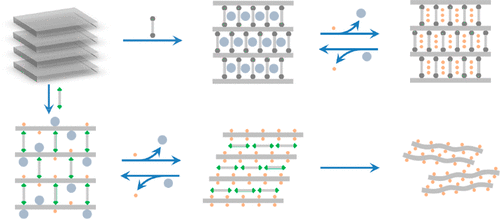当前位置:
X-MOL 学术
›
Cryst. Growth Des.
›
论文详情
Our official English website, www.x-mol.net, welcomes your
feedback! (Note: you will need to create a separate account there.)
A Metal–Ligand Layer Compatible with Various Types of Pillars for New Porous Coordination Polymers
Crystal Growth & Design ( IF 3.2 ) Pub Date : 2020-09-15 , DOI: 10.1021/acs.cgd.0c01078 Yun Li 1 , Zong-Wen Mo 1, 2 , Xue-Wen Zhang 1 , Kai Zheng 1 , Dong-Dong Zhou 1 , Jie-Peng Zhang 1
Crystal Growth & Design ( IF 3.2 ) Pub Date : 2020-09-15 , DOI: 10.1021/acs.cgd.0c01078 Yun Li 1 , Zong-Wen Mo 1, 2 , Xue-Wen Zhang 1 , Kai Zheng 1 , Dong-Dong Zhou 1 , Jie-Peng Zhang 1
Affiliation

|
Pillared-layer structures are classic for porous coordination polymers (PCPs), but suitable metal–ligand layers for such structures are rare. Here, we report a cationic {Zn2(pzdc)}+ (H3pzdc = 3,5-pyrazoledicarboxylic acid) layer compatible with various types of pillar ligands. Solvothermal reactions of Zn(NO3)2·6H2O and H3pzdc with 4-(pyridin-4-yl)-1H-pyrazole (Hpypz), 1,4-benzenedicarboxylic acid (H2bdc), or 2-amino-1,4-benzenedicarboxylic acid (H2abdc) in a mixed solvent of H2O and N,N-dimethylformamide (DMF) produced three pillared-layer PCPs, namely [Zn4(pzdc)2(pypz)2]·guest (1), [Zn4(pzdc)2(bdc)(H2O)1.53(DMF)0.47]·guest (2), and [Zn4(pzdc)2(abdc)(H2O)1.52(DMF)0.48]·guest (3), respectively. Single-crystal X-ray analyses revealed that the {Zn2(pzdc)}+ layers are fully pillared by pypz− in 1 and half pillared by bdc2− and abdc2− in 2 and 3, because the anionic pillars possess different charges. Consequently, 1 shows one-dimensional (1D) channels with a small porosity and 2 and 3 show 2D channels with large porosities, both of which were verified by N2 and CO2 adsorption isotherms. While 1 has no coordinated solvent molecules and exhibits a high water stability, 2 and 3 possess coordinated solvent molecules and quickly transform to crystals of 2D coordination networks in water, [Zn4(pzdc)2(OH)2(H2O)6]·H2bdc·4H2O (4) and [Zn4(pzdc)2(H2abdc)(OH)2(H2O)5]·2H2O (5), respectively, which can be further exfoliated into ultrathin nanosheets in an ammonia solution.
中文翻译:

与新型新型多孔配位聚合物的各种类型的支柱兼容的金属配体层
多孔层结构是多孔配位聚合物(PCP)的经典,但是很少有适合这种结构的金属-配体层。在这里,我们报告与各种类型的柱配体相容的阳离子{Zn 2(pzdc)} +(H 3 pzdc = 3,5-吡唑二羧酸)层。Zn(NO 3)2 ·6H 2 O和H 3 pzdc与4-(吡啶-4-基)-1 H-吡唑(Hpypz),1,4-苯二甲酸(H 2 bdc)或2的溶剂热反应H 2 O和N,N的混合溶剂中的-氨基-1,4-苯二甲酸(H 2 abdc)-二甲基甲酰胺(DMF)产生了三个柱状层PCP,即[Zn 4(pzdc)2(pypz)2 ]·客体(1),[Zn 4(pzdc)2(bdc )(H 2 O)1.53(DMF)分别为0.47 ]·客座(2)和[Zn 4(pzdc)2(abdc)(H 2 O)1.52(DMF)0.48 ]·客座(3)。单晶X射线分析显示{Zn 2(pzdc)} +层完全由pypz - in 1支撑和由半柱BDC 2-和ABDC 2-在2和3,这是因为阴离子柱具有不同的电荷。因此,1表示孔隙度较小的一维(1D)通道,而2和3表示孔隙率较大的2D通道,这两个通道均已通过N 2和CO 2吸附等温线验证。尽管1没有配位的溶剂分子并且具有很高的水稳定性,但是2和3拥有配位的溶剂分子并且可以在水中快速转化为2D配位网络的晶体[Zn 4(pzdc)2(OH)2(H 2 O)6 ]·H 2 bdc·4H 2 O(4)和[Zn 4(pzdc)2(H 2 abdc)(OH)2(H 2 O)5 ]·2H 2 O(5)分别可以在氨溶液中进一步剥落成超薄纳米片。
更新日期:2020-10-07
中文翻译:

与新型新型多孔配位聚合物的各种类型的支柱兼容的金属配体层
多孔层结构是多孔配位聚合物(PCP)的经典,但是很少有适合这种结构的金属-配体层。在这里,我们报告与各种类型的柱配体相容的阳离子{Zn 2(pzdc)} +(H 3 pzdc = 3,5-吡唑二羧酸)层。Zn(NO 3)2 ·6H 2 O和H 3 pzdc与4-(吡啶-4-基)-1 H-吡唑(Hpypz),1,4-苯二甲酸(H 2 bdc)或2的溶剂热反应H 2 O和N,N的混合溶剂中的-氨基-1,4-苯二甲酸(H 2 abdc)-二甲基甲酰胺(DMF)产生了三个柱状层PCP,即[Zn 4(pzdc)2(pypz)2 ]·客体(1),[Zn 4(pzdc)2(bdc )(H 2 O)1.53(DMF)分别为0.47 ]·客座(2)和[Zn 4(pzdc)2(abdc)(H 2 O)1.52(DMF)0.48 ]·客座(3)。单晶X射线分析显示{Zn 2(pzdc)} +层完全由pypz - in 1支撑和由半柱BDC 2-和ABDC 2-在2和3,这是因为阴离子柱具有不同的电荷。因此,1表示孔隙度较小的一维(1D)通道,而2和3表示孔隙率较大的2D通道,这两个通道均已通过N 2和CO 2吸附等温线验证。尽管1没有配位的溶剂分子并且具有很高的水稳定性,但是2和3拥有配位的溶剂分子并且可以在水中快速转化为2D配位网络的晶体[Zn 4(pzdc)2(OH)2(H 2 O)6 ]·H 2 bdc·4H 2 O(4)和[Zn 4(pzdc)2(H 2 abdc)(OH)2(H 2 O)5 ]·2H 2 O(5)分别可以在氨溶液中进一步剥落成超薄纳米片。











































 京公网安备 11010802027423号
京公网安备 11010802027423号